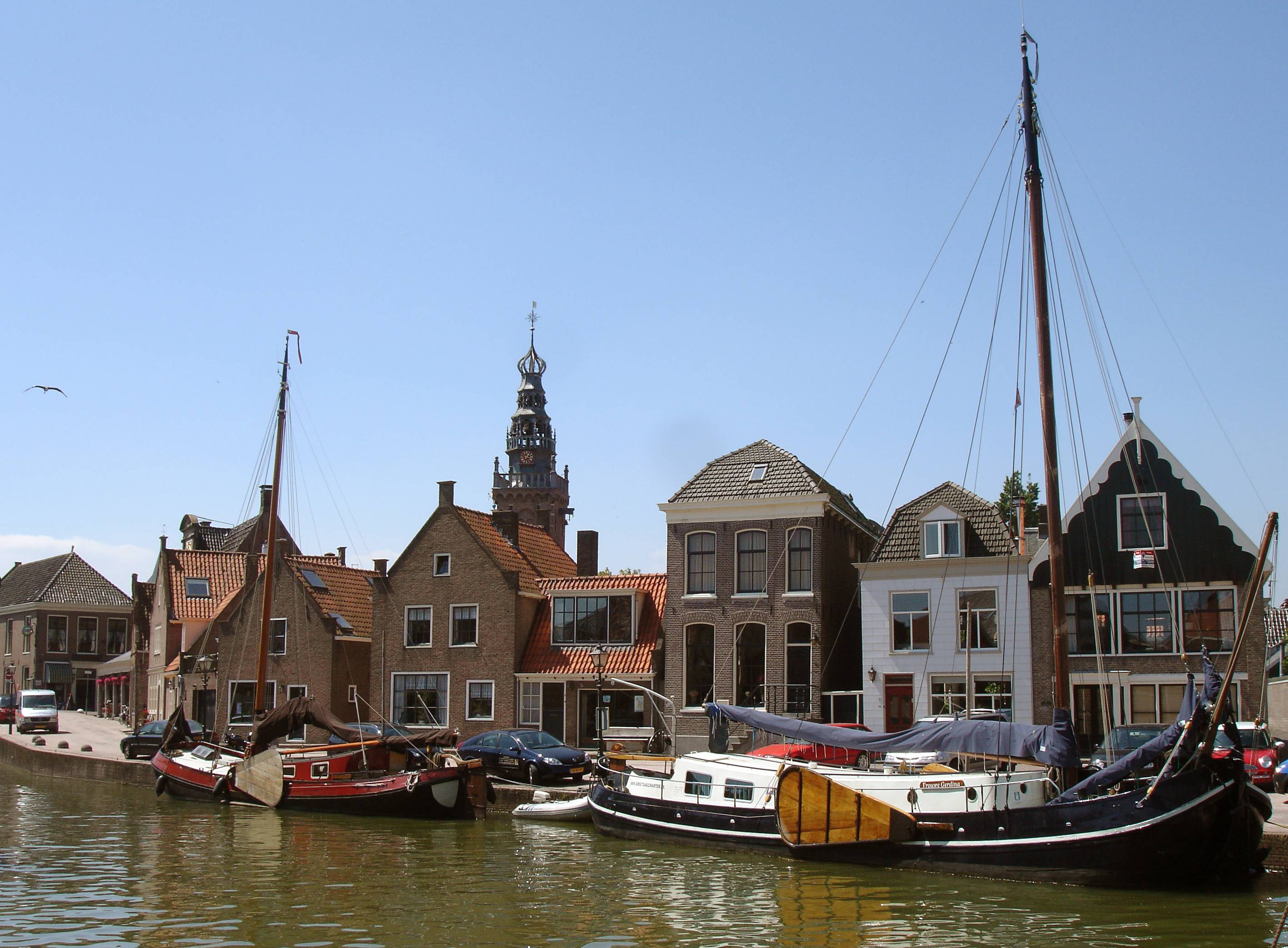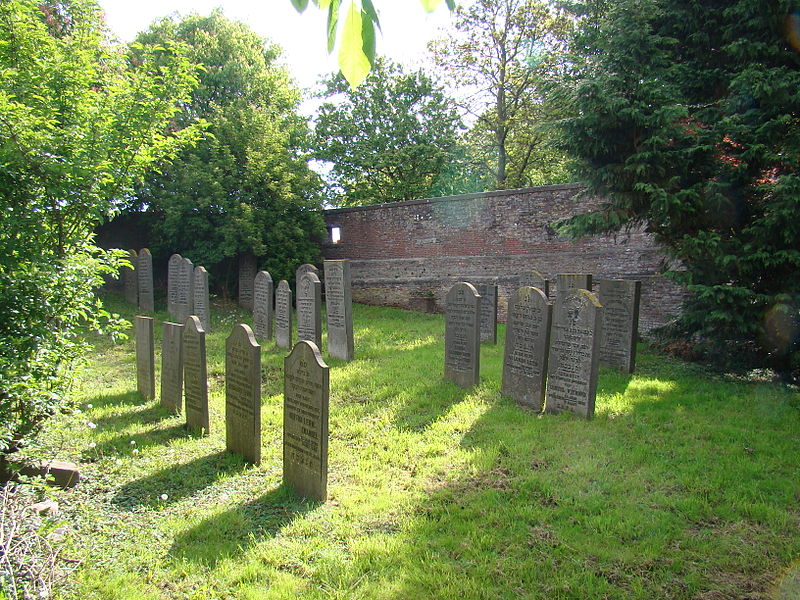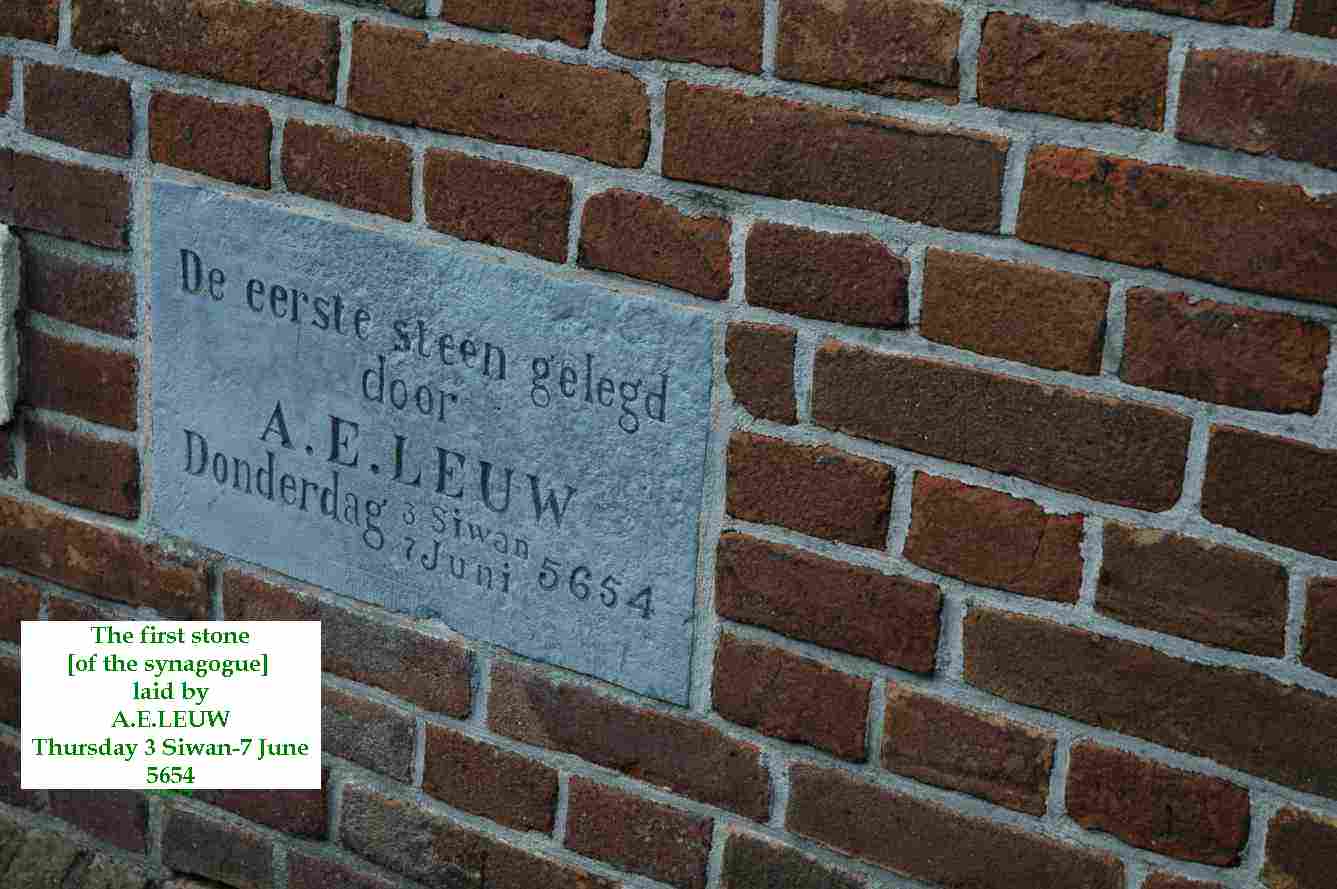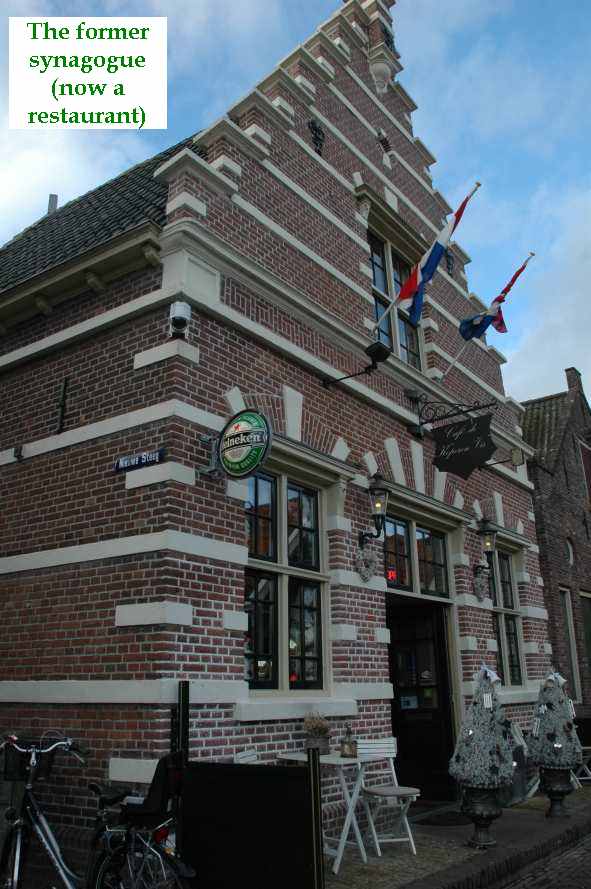The Jewish Community in Monnickendam
Names mentioned in this article (in the order of their appearance):
Before the names adoption:
Comphrigh (Gompert) Moses, Barent Jacobs Cohen, Gerzon Salomons(Mol), Eliazar Philip Levie, Salomon Gerson , Rebecca Salomon Gerson, Samuel Ijsaacks, Abraham Levy of Amsterdam, Maritgen Jacobs Levi, Jacob Vos, Leendert Askus, Joseph Gerson, Pieter Vos, Benjamin Salomons, Rebekka Ysaacks, Mighiel Salomons, Jacob de Spinoza of Amsterdam, Jacob Ijzaaksz.
After the names adoption:
Hartog Salomon Mol, Gerson Salomon Mol , J. Vredenburg (Amsterdam),Aaltje van der Goen, Nathan Emanuel Leuw, Moses Leuw, Emanuel Leuw, Andries Witmond, Lou Cohen.
During the first half of the 17th century Jewish refugees were not interested in Monnickendam. The first registration only took place in 1685. This was also the year in which the first wedding between a Jewish male and a non-Jewish female took place. Among the Jews in Monnickendam were butchers, fish mongers, dealers in textiles and before that they were also money/currency dealers.
In 1680 the first sale of a house to Comphrigh (Gompert) Moses, Jew and butcher in this town’ was transacted.
Bad times
During the period of 1690 – 1720 things did not fare well in Monnickendam. Among others this is evident from the rent people had to pay for their houses. Only three Jews owned their homes.
The Synagogue
In September 1686 Comphrigh Mozes bought a house and a yard in one of the oldest streets, the Groote Noord, which was frequented by fishermen and merchants because it was a short distance from the harbor. Very soon, in December, he bought another house and yard which upon its sale in 1689 was already called “Jodenvergaderplaetse” (Jewish meeting place),
In 1687 a dispute erupted about whether to have synagogue services or not as there would not be a minyan (10 grown-up men). There was also a discussion between Gompert Mozes and Barent Cohen about the cost of maintenance. These questions were submitted to the Jewish Council in Amsterdam.
The officials in Amsterdam decided that services were to be held in the synagogue which Gompert founded. The expenses for the establishment of this synagogue would be borne by Gompert and not by Barent Cohen. Furthermore, a rapprochement between the two parties would be affected.
Thus Gompert Mozes’ synagogue on the Grote Markt became the only one in Monnickendam. From the notes of the mayors for the year 1766 it is clear that a house was rented in order to store goods and also to serve as a synagogue. In 1767 Gerzon Salomons (later called the family Mol) buys a house and yard on Noordeinde for 180 guilders. Among the Jewish community Gerson Salomonsz and Eliazar Philip Levie were appointed supervisor and treasurer . In 1770 Gerson Salomonsz was replaced by his son, Salomon Gerson as supervisor. In 1785 the house and yard on Noordeinde which belonged to Rebecca, the daughter of Salomon Gerson, were sold. It is not clear whether the end of the existence of this second synagogue could be attributed to lack of finances or a lack of grown-up Jewish males.
In 1733 there were no more than 4 Jewish families who owned 7 properties. This was still so in 1747, but there is more known about the number of Jewish inhabitants: 8 grown-ups and 6 children. One could therefore not have held any synagogue services , even if one had been available.
Salomon Gerson Mol died in 1813. Religious services were regularly held at his home, as he was the man who succeeded his father, Gerson Salomon as supervisor of the Jewish community in Monnickendam in 1770. The son of Salomon Gerson Mol, Hartog, sold his part of that house to his brother Gerson who had inherited the other part of the house. However, Gerson Salomon Mol sold the house in 1814 to the Jewish community. Nothing is known about refurbishing or of the furnishings of the building as the one standing on this place now dates from 1894.
On March 27th, 1894 the synagogue which was inaugurated in 1814 in Monnickendam went up in flames. Very soon afterwards, on May 4th the leaders of the Jewish community wrote to the municipality that they were planning to build a new synagogue and house on the same place, now entirely from stone.
On Wednesday, September 26th, 1894 the new synagogue was ceremoniously inaugurated. The building now had its characteristic stepped gable. For the inauguration the building was decorated inside and outside with flowers and flags. Several local personalities took part at the ceremony. The festive speech was held by Mr. J. Vredenburg of Amsterdam. He gave an explanation about the inauguration and talked about the significance of a synagogue for Jews. He also noted with pleasure the presence of the Mayor and Aldermen, as well as clergymen. He also paid tribute to the free Netherlands and the Dutch nation, because of the example she gave to other nations.
The Jewish Religion School and Bath House
In 1846 Aaltje van der Goen died and she left her house in the Kerkstraat to the Jewish community in order to refurbish it into a school for religious tuition and a ritual bath house. It is known that fire broke out in the building in 1883, but this was quickly extinguished. In 1886 it was decided that the building should be torn down.
The Jewish Cemetery
In 1677 it is mentioned that three Jewish families requested a place “to bury their dead”. We know that it concerned the earlier mentioned Comprich Mozes, the butcher and Barent Jacobs, the pawnbroker at the Loan Bank. The mayors allotted a plot of land for this purpose near the Zuiderpoort. At the request of the Jewish community permission was given in 1783 to build a wall around this cemetery plot.
The Loan Bank of the “Lombard”
On March 1668 Samuel IJsaacks requested permission to establish a Loan Bank. Only in 1670 Samuel IJsaacks and Abraham Levy of Amsterdam received the permit to establish a money lending Bank or pawnbroker shop, under certain conditions. In February 1674 they renounced this permit and in August of the same year it was transferred to Barent Jabobsz. Barent Jacobsz Cohen had taken over the bank from Samuel IJsaacksz and Abraham Levi by contract until 1678 for the amount of 50 guilders per year. This amount was later increased to 275 guilders per year.
In 1685 we hear about Barent Jabobs again, as licensee of the Bank van Leningh, or Loan Bank. It seems, therefore that trading in money was done by Jewish money lenders.
After the death of Barent Jacobs in 1690 his widow, Maritgen Jacobs Levi, had difficulties in paying the yearly sum of 275 guilders . She pays it until 1693 and then there is a new contract for 8 years and she pays only 150 guilders, because of ‘bad times’.
Later, in 1705, Comprigh Moijsis (the founder of the synagogue) leased the bank.
The next mentioning of the existence of a bank is in March 1717. A certain Jacob Vos made an offer of 150 guilders, but it is not known whether this was accepted. In April 1733 Leendert Askus (perhaps from Ashkenasim) rented the Lombard together with the previously mentioned Joseph Gerson, instead of Pieter Vos (son of Jacob Vos?) whose rent or lease had been cancelled. The new contract was intended to run until May 1740. At the time, the loan bank was established on the corner of Zuideinde and Goijse Kaij. Joseph Gerson kept the bank almost until the end of the contract. He dies in April 1740 and his widow waives the opportunity to continue leasing the bank. The town mayors then decide to lease the bank publicly – publishing an announcement in a newspaper, but persons of the Jewish belief were not to be accepted.
Foreigners
In times of declining business foreigners are not welcome. On top of that the sheriffs and aldermen were pressured to tell Jews to leave and not to let them pursue their trades. However, it turns out that in spite of this, almost all the 46 Jews who requested permission from the city council to come and live in Monnickendam with their families or who wanted to buy citizenship, were granted this permission.
In 1696 the sheriffs and councilmen found it necessary to take action against the use of abusive language. As from September 1696 measures were taken, focusing on many but “especially the young youths who did not take into consideration all kinds of people and mainly those of the Jewish belief who live here, to point at them, call them names, make fun of them, to beat them and throw stones at them, against all right and reason – and which should not be so” with the prospect of a 12 guilders fine as punishment.
Departure of Jewish inhabitants
In 1720 the city council of Monnickendam tried to breathe new life into the city’s economy by offering the Sefardic Jews freedom of religion if they would settle in this town, but this suggestion had no results and therefore it were mainly Ashkenazi Jews who resided in the city. These, however, also departed and so there was no sign anymore of a Jewish community. Nevertheless in 1717 and 1718 there were Portuguese Jews who bought houses in the town, but between 1719 and 1723 these were sold to Monnickendam citizens as the Portuguese Jews remained in Amsterdam.
The progress/evolvement of settlement
There exists a list of buying and selling data of houses indicating how long Jewish inhabitants lived in their respective homes. Thus we know that Benjamin Salomons bought a house near the harbor in 1726, but in 1727 he was banned from Holland and West Friesland for ten years because he had acted against the laws of the land. He was married to Rebekka Ysaacks, who died in 1726. He then asked permission to marry her sister and this request was turned down. Thereupon he married her anyway, which was against the local laws and that is why he was banned for 10 years from the region.
Mighiel Salomons, the butcher, lived in another house. He was sent away from the town because did not adhere to hygienic regulations. In the end this house was bought by Jacob de Spinoza of Amsterdam, presumably as an investment, as he never came to Monickendam.
Jacob IJzaaksz was the only Jew who had a hunting barge ferry with which he sailed to Buiksloot and back on a regular daily basis. He kept this up until 1751, when he sold the barge.
The processing of cheese making
In 1770 Gerzon Salomonsz, a Jew living in Monnickendam informed the mayor that either he or his son had to go twice a day to Zed (Zedde) in order to make cheese for the Jews and that the toll collector near the Zedde wanted to collect toll each time they had to pass the toll-gate. He therefore asked to mayor whether some arrangement could be made so he wouldn’t have to pay each time. The following decision was made: -
“According to the law in use by the Jews, the farmers are obliged to make cheese by themselves, and therefore the Jews have to stay with the farmers and to go there and back. Because of these reasons it has been approved and according to articles 31e and 32e of the convention for roads of 1660, to declare him [Gerzon Salomonsz ]released of the necessity to pay tolls twice daily, mornings and evenings from here to Zedde and back again and be allowed to pass the concerning toll-gate and in case he goes a different route he will be obliged to pay the full amount of the toll.”
Changes
After the establishment of the Batavian Republic in 1795 the national assembly decided to end the special status of the Jews: “no Jew will be excluded from any rights or privileges connected to the Batavian civil rights and which he requests to acquire”.
Amazing was, however, that the majority of the Jews was against the granting of complete equal rights because this would mean an end for the Jewish leaders of a centuries-long autonomy. Jews were tolerated in most of the towns in Holland, but they remained strangers because of their way of life and their behavior. They lived according to their own standards and vested rights, like synagogues, own cemeteries, circumcisions, ritual baths, butchers, kosher bakers and cheese makers and not to forget the care for the poor which was completely dependent on the richer Jews and which had nothing to do with any of the communities of other beliefs and whose interference was not tolerated.
On September 2nd, 1796 however, the equalization of the Jews was a fact and the so-called clerical laws of the ‘Jewish Nation ’ were canceled by public law. The Ashkenasi parnassim felt that this was a reduction of their power and resisted these laws. In Monnickendam, though, this had hardly any impact.
The promised civil equalization in 1796 gave the Jews a substantial impetus. The establishment of a new Jewish community in Monnickendam started with the transaction of seven houses. A list of Jewish inhabitants from the year 1808 shows there were 9 men, 11 women and 30 children of whom several above the age of 13. In 1811 the names adoptions were added to the list.
The consistory of Amsterdam and surroundings
The French regime established a consistory, a kind of rabbinate and the consistory of Amsterdam was also in charge of the Zuiderzee department to which Monnickendam belonged as well. In 1813 a representative of the consistory visited Monnickendam who was satisfied with the local state of affairs as managed by a ‘chief rabbi’. He was, however, worried about the great poverty. What worried him mostly was the fact that there was no Jewish education teacher for the children – a problem to which there seemed to be no solution. Religious services were apparently held at the home of one of the community members, as the synagogue was closed down in 1785. The question of a synagogue building probably came up in a discussion with the chief rabbi.
Decrease in the number of Jewish community members
50 Jews lived in Monnickendam in 1808 and in 1815 there were only 30 left. Originally there were only 20 Jews registered in 1815, but that was by mistake, as a number of them had been placed by accident on a list of Baptists.
Land registry data
The land registry was introduced in 1832 and shows that Jewish real estate property was minimal. Of the eight Jewish families living at that time in Monnickendam only five owned real estate.
Objets d’art/precious objects
From a letter addressed to the mayor and aldermen of Monnickendam it appears that in 1867 Nathan Emanuel Leuw owned several valuable objects. It seems that during that period Jews had a keen interest in such objects, like for instance the staff and sword of an admiral and the large silver commemorative medallion of Bossu.
The first years of the 20th century
Around 1920 only sixteen Jewish families still lived in Monnickendam. This was enough for minyan, on condition they all attended. That was not always the case because of all kinds of reasons. The Jewish leadership did not want to run the risk that synagogue services could not be held on High Holidays, so they found the following simple solution. They invited students of the Dutch Israelite Seminary in Amsterdam to stay over the Holidays.By doing so they helped both the Monnickendam Jewish community as they now were sure to have a minyan, as well as the students, because they saved them a few days cost and living expenses.
More and more Jews left. The kehilla lost its reason for existence. The synagogue changed hands, and was transferred to families Langendijk and Oostveen – according to a newspaper report of October 1949. The last synagogue service was held in 1934 on the occasion of a chuppa (wedding).
The tax of a quarter per week was still being collected.
On Shabbath/Saturdays messrs. Moses Leuw and his cousin Emanuel Leuw stayed to learn (laynen). The community possessed three “Sifrei Torah” (Torah Scrolls). Before 1940 – after German refugees settled in the Netherlands – these scrolls were transferred to the Jewish community in Zandvoort at the request of the permanent commission. The second synagogue of Zandvoort, however, was blown up in 1940 so these were forever lost.
The Jewish community of Alkmaar received the ornaments of worship. Mr. Schoonheim writes in his booklet ‘the Jewish community of Edam’ that the synagogue ornaments of Edam were probably transferred to the Jewish community in Monnickendam because those of Monnickendam had been lost during the fire of 1894. The dilapidated synagogue and ritual bath house in Edam had already been demolished in 1887, whereas the three remaining Jewish families resorted under the community of Monnickendam.
On enquiry at the Jewish community in Alkmaar it turned out that the Monnickendam ornaments (silver towers, crowns and candelabra’s) were loaned to the Jewish Historical Museum in Amsterdam.The Torah coats and parochet remained in Monnickendam, in safe- keeping by Messrs. Andries Witmond and Lou Cohen, the last parnassim of the community. In 1940 these possessions were given for safe-keeping to the non-Jewish garage owner, Mr. J. van de Gier, but before they could be returned after the war, there was a fire in the garage, where the items were being kept.
From the historical summary in “Pinkas” (published in Deventer by Kluwer) for the period between the 17th and 20th century it can be concluded that there were 17 Jews in Monnickendam in 1942.
Of those only one returned after the war.
Source:
website http://www.oudmonnickendam.nl/
Download: Joden in Monnickendam
File namee: VOM 1996 - 3 van 4
File Type: doc
Jaarboek 1996
Extracted from source:Yael (Lotje) Ben Lev-de Jong
Translation into English:Nina Mayer
End editing English:Trudi Asscher
Coordinating of final version:Ben Noach
[an error occurred while processing this directive]
[an error occurred while processing this directive]

The Town Monnickendam

Monnickendam the Remains_of the Citywall and the Jewish Cemetery

